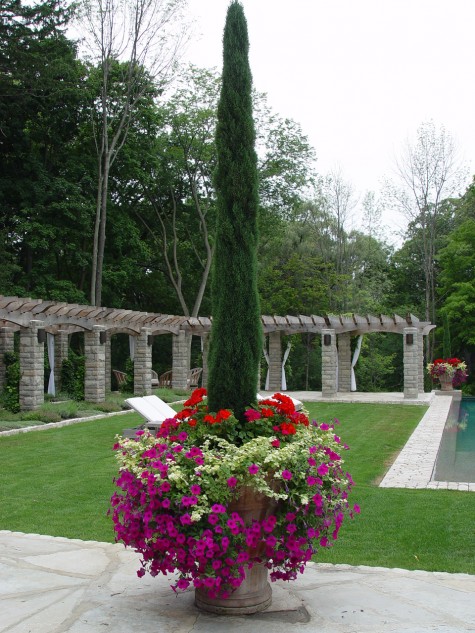 On my top ten list of frequently asked questions, the culture of evergreens in pots ranks right up there. In theory it sounds great. You invest in an evergreen which will provide you with a center of interest that looks great no matter the season. Perhaps there will be room on the edges for a few seasonal annuals. The work and expense up front is considerably more than planting smaller and less expensive plants, but then you are done. Redoing one’s pots with new plants every new season no doubt is a lot of work and expense. But as with everything connected to growing a garden, one is rarely “done”. The Italian cypress in the pot pictured above is not hardy in Michigan, nor can one leave a terra cotta pot such as this one outdoors during the winter. The cypress has to be wintered in a greenhouse cold storage area, and replanted every spring. The pot is put away. There is time and trouble hauling it back to the greenhouse in late fall.
On my top ten list of frequently asked questions, the culture of evergreens in pots ranks right up there. In theory it sounds great. You invest in an evergreen which will provide you with a center of interest that looks great no matter the season. Perhaps there will be room on the edges for a few seasonal annuals. The work and expense up front is considerably more than planting smaller and less expensive plants, but then you are done. Redoing one’s pots with new plants every new season no doubt is a lot of work and expense. But as with everything connected to growing a garden, one is rarely “done”. The Italian cypress in the pot pictured above is not hardy in Michigan, nor can one leave a terra cotta pot such as this one outdoors during the winter. The cypress has to be wintered in a greenhouse cold storage area, and replanted every spring. The pot is put away. There is time and trouble hauling it back to the greenhouse in late fall.
 This 25 year old rosemary has spent 25 winters in a glass house. It is an evergreen-should you live in Greece or Italy, or California. Michigan winters are fiercely cold. However unfair it seems, rosemary is just not hardy here. In return for the extraordinary pleasure of owning an old rosemary such as this one, my client is willing to weather what it takes to keep it alive and healthy.
This 25 year old rosemary has spent 25 winters in a glass house. It is an evergreen-should you live in Greece or Italy, or California. Michigan winters are fiercely cold. However unfair it seems, rosemary is just not hardy here. In return for the extraordinary pleasure of owning an old rosemary such as this one, my client is willing to weather what it takes to keep it alive and healthy.
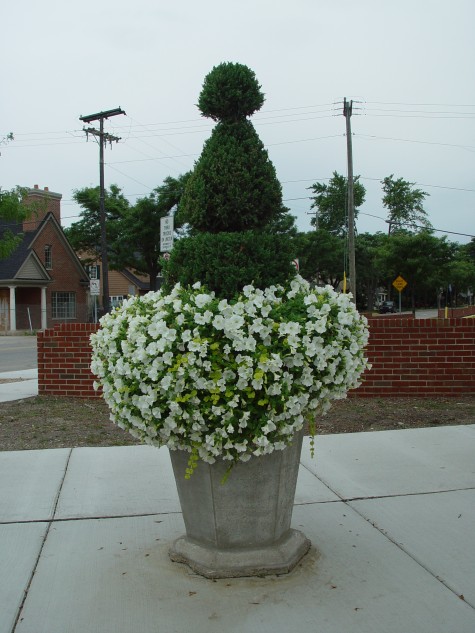 Junipers on the other hand are ruggedly hardy. But key to the successful culture of evergreens in pots is to understand that at best, they tolerate this treatment. Growing a plant in a pot is actually about growing a plant with its roots above ground. No plant likes this-they may or may not put up with it. Siting is the first crucial issue. Evergreens must survive the winter and stay green without being able to take up water. A windy location can dessicate the needles-thus the term, winter burn. A winter burned plant is still alive, but it’s not a good look. It will take time to grow out of the scorched needle phase.
Junipers on the other hand are ruggedly hardy. But key to the successful culture of evergreens in pots is to understand that at best, they tolerate this treatment. Growing a plant in a pot is actually about growing a plant with its roots above ground. No plant likes this-they may or may not put up with it. Siting is the first crucial issue. Evergreens must survive the winter and stay green without being able to take up water. A windy location can dessicate the needles-thus the term, winter burn. A winter burned plant is still alive, but it’s not a good look. It will take time to grow out of the scorched needle phase.
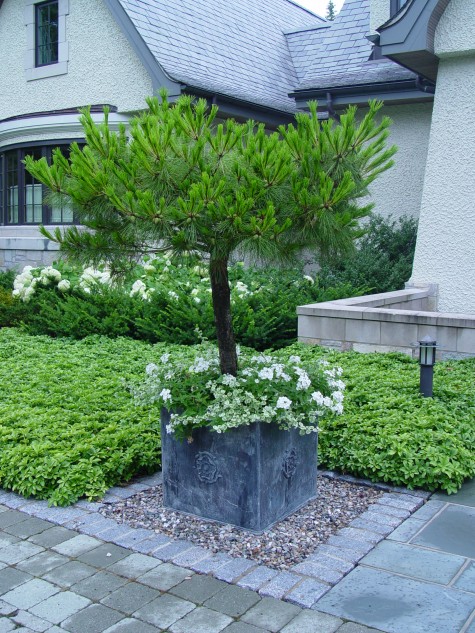 Mugho pines, both the shrubby and the topiary forms, have the reputation of good survivability in pots. Critical to that survival is proper watering. Should you quit watering this evergreen when your geraniums go down from frost, you are almost certain to loose it. Judicious watering right up until the soil ball is frozen solid is a must. If this evergreen were to unfreeze in a January thaw, a watering might be in order. When the soil thaws in the spring, the watering should be resumed-even if this is long before you plant your other pots. What evergreens in containers require is not for the faint of heart.
Mugho pines, both the shrubby and the topiary forms, have the reputation of good survivability in pots. Critical to that survival is proper watering. Should you quit watering this evergreen when your geraniums go down from frost, you are almost certain to loose it. Judicious watering right up until the soil ball is frozen solid is a must. If this evergreen were to unfreeze in a January thaw, a watering might be in order. When the soil thaws in the spring, the watering should be resumed-even if this is long before you plant your other pots. What evergreens in containers require is not for the faint of heart.
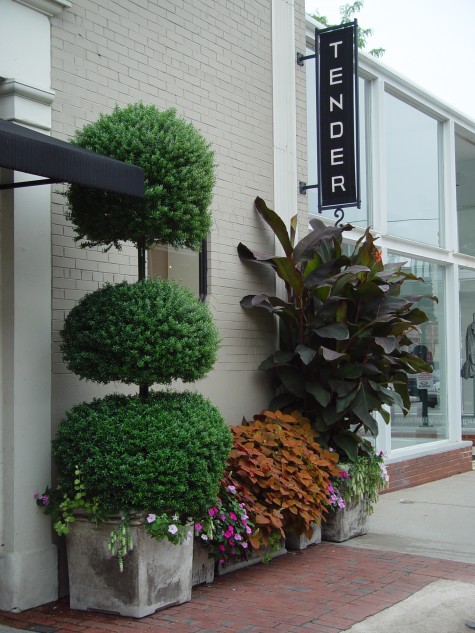 This grand old myrtle topiary was beautifully maintained, for 11 summers. The 12th winter in the greenhouse, a furnace went out, and it froze. It has been in the greenhouse for the past two years; we are trying to coax it back to health. Owning plants like this is a big committment with little in the way of any guarantee. Just because you have provided next to perfect care for a long time does not mean you cannot loose it. Evergreens in containers are for gardeners who relish risk.
This grand old myrtle topiary was beautifully maintained, for 11 summers. The 12th winter in the greenhouse, a furnace went out, and it froze. It has been in the greenhouse for the past two years; we are trying to coax it back to health. Owning plants like this is a big committment with little in the way of any guarantee. Just because you have provided next to perfect care for a long time does not mean you cannot loose it. Evergreens in containers are for gardeners who relish risk.
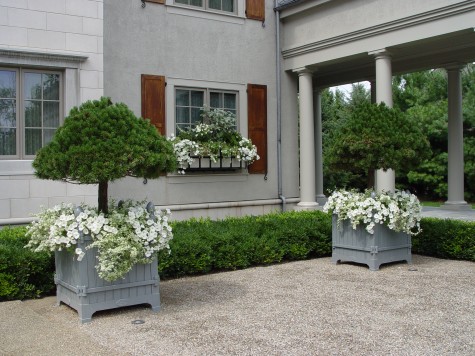 These mugho pines on standard have lived in these orangery boxes for 6 years. At some point, they should be taken out, root pruned, and reset in fresh soil. They will most certainly decline without this maintenance. No plant stays the same, just because its container stays the same. Plants will prosper and grow, or sulk and decline-one or the other.
These mugho pines on standard have lived in these orangery boxes for 6 years. At some point, they should be taken out, root pruned, and reset in fresh soil. They will most certainly decline without this maintenance. No plant stays the same, just because its container stays the same. Plants will prosper and grow, or sulk and decline-one or the other.
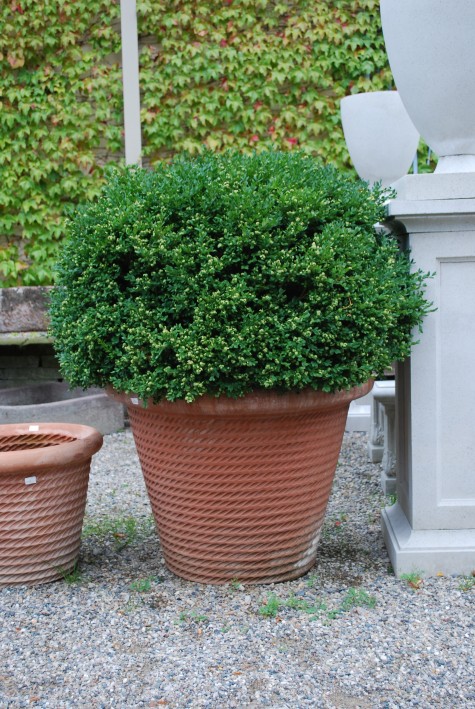 Boxwood is a good choice for a container. As this French terra cotta pot cannot be left out, I wheel this entire assembly into the garage for the winter. This species, Buxus Microphylla, is very tough; my hedge on the southside of my building never winter burns. In the same spirit, it tolerates a mostly dark and unheated garage from November until March. At the first sign of moderating temperatures, I take it back outside. A garage can get too warm for holding plants dormant long before the outside temperatures moderate.
Boxwood is a good choice for a container. As this French terra cotta pot cannot be left out, I wheel this entire assembly into the garage for the winter. This species, Buxus Microphylla, is very tough; my hedge on the southside of my building never winter burns. In the same spirit, it tolerates a mostly dark and unheated garage from November until March. At the first sign of moderating temperatures, I take it back outside. A garage can get too warm for holding plants dormant long before the outside temperatures moderate.
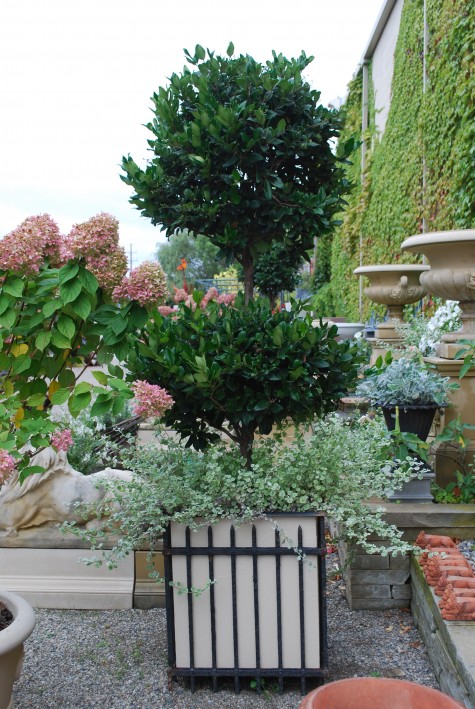 Waxleaf privets are an aristocratic cousin of our hardy privet. The large leaves are lustrous and juicy looking. They are hardy in zone 7, so they can be wintered in an indoor spot without much in the way of heat. They grow slowly, and are available in big sizes; there is demand for the topiary forms from gardeners in more temperate regions. They take well to pruning and shaping.
Waxleaf privets are an aristocratic cousin of our hardy privet. The large leaves are lustrous and juicy looking. They are hardy in zone 7, so they can be wintered in an indoor spot without much in the way of heat. They grow slowly, and are available in big sizes; there is demand for the topiary forms from gardeners in more temperate regions. They take well to pruning and shaping.
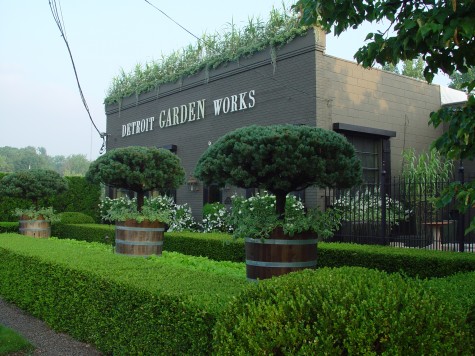
These giant scotch pine on standard are breathtakingly beautiful. I kept them in equally giant wood barrels for the better part of two years, before I sold them. Evergreens need big rootballs to insure successful transplanting-so pots for evergreens need to be large. Boxwood balls are usually larger than their foliage diameter. A well-grown evergreen in a gorgeous container is hard to beat; most likely I will keep on trying to grow them.